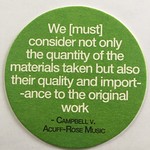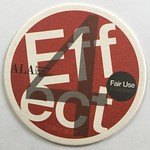 Yes, there were copyright related sessions at the ALA Annual Conference in Washington, DC.
Yes, there were copyright related sessions at the ALA Annual Conference in Washington, DC. Copyright Help 5 cents
This was not a session. A group of copyright librarians had a Copyright Help booth near the registration area and I thought this was awesome. I have no idea how many people may have stopped to ask a question. However, I do know that we need to recognize that asking questions is important and helpful, especially when you can someone who understands copyright law. Kyle Courtney, pictured above at the booth, has spearheaded an effort to create copyright first responders. Like this booth, those first responders are available to help triage questions people might have.
Resources
- Harvard’s Copyright First Responders to the Rescue (2014)
- Copyright First Responders webinar now available (2017)
- Kyle Courtney and the Copyright First Responders (2018)
Empowering Libraries to Lend Digital Books via Controlled Digital Lending
Michelle Wu, Jim Michalko, and Kyle Courtney gave this session on controlled digital lending (CDL). Description:
Book scanning projects have made tremendous strides in bringing public domain literature online for the world's scholars and enthusiasts, but materials published after 1923 are still not widely available due to policy and copyright uncertainties. The Internet Archive has developed a controlled digital lending service (CDL) that enables libraries to digitize and lend a digital version of a physical volume stored on their shelves. Through CDL, a library circulates the exact number of copies it owns, regardless of format, while ensuring that users cannot redistribute or copy the digitized version. Using CDL, libraries can make available the 20th-century scholarship that is largely absent from their digital holdings in a way that respects the rights of authors and publishers. This panel will bring together librarians, publishers, and ebook specialists to share their experiences about serving patrons via controlled digital lending.With controlled digital lending, a library can digitize a book, store the physical book, and then lend the digital version to one person at a time. In other words, lending the digital book in the same way you would lend a physical book. Having the book in digital form would allow it to be loaned more widely. This uses both Section 109 and Section 107 of U.S. Copyright Law.
What's the catch?
The Position Statement on Controlled Digital Lending notes the following:
libraries should (1) ensure that original works are acquired lawfully; (2) apply CDL only to works that are owned and not licensed; (3) limit the total number of copies in any format in circulation at any time to the number of physical copies the library lawfully owns (maintain an “owned to loaned” ratio); (4) lend each digital version only to a single user at a time just as a physical copy would be loaned; (5) limit the time period for each lend to one that is analogous to physical lending; and (6) use digital rights management to prevent copying and redistribution.If this area is of interest to you, I encourage you to read the resources below.
Resources
- Controlled Digital Lending by Libraries (website)
- A White Paper on Controlled Digital Lending of Library Books (2018)
- Controlled Digital Lending of Library Books (2018)
- Controlled Digital Lending Concept Gains Ground (2018)
- DPLAfest 2019: Session highlights (2019) - Yes, this includes information on CDL, which was discussed at this conference.
Figuring out the Fourth Factor
With more then 21,000 participants and hundreds of vendors in the exhibit hall, there is clearly too much to do. So I unable to attend this session, "Figuring out the Fourth Factor: Copyright librarians discuss fair use case law," but thankfully American Libraries wrote an article on it.
Coasters from the Copyright Help Booth
Here are coasters about fair use factors 2, 3, and 4. Sadly, there didn't seem to be a coaster available for factor 1.





No comments:
Post a Comment